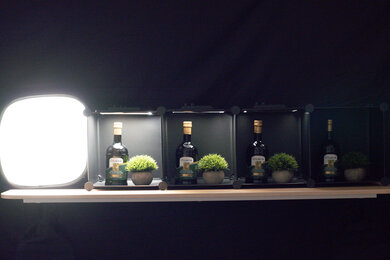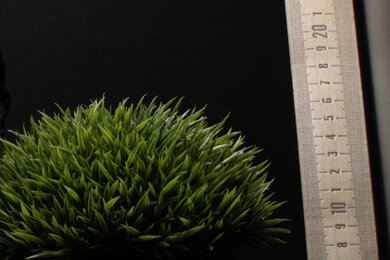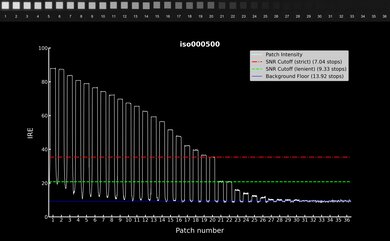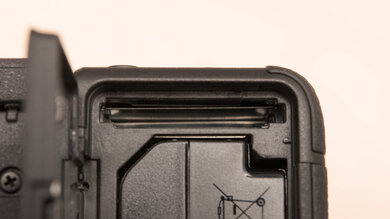The Sony α6600 is Sony's flagship APS-C camera, sitting above the similar Sony α6400. Though the two share the same 24-megapixel APS-C sensor, the a6600 adds in-body image stabilization (IBIS), a bigger battery, and slightly sturdier build quality. Like other Sony cameras, it has an excellent autofocus system, and its tilting screen can flip all the way up, making this a solid APS-C option for videos and vlogs as well as photography.
Our Verdict
The Sony a6600 is great for travel photography. It has a relatively compact body that's easy to store and travel with. It's also weather-sealed against moisture and dust. Depending on how you use it, the camera also has an incredibly long battery life, meaning it can last through long hikes or days on the go. However, its menu system can be confusing and difficult to navigate.
- Relatively portable.
- Excellent autofocus system.
- Exceptional battery life.
- Weather-sealed.
- Confusing menu system.
- Limited touchscreen functionality.
The Sony Alpha 6600 is great for landscape photography. It feels well-built and comfortable, and its body is weather-sealed against moisture and dust. It has great dynamic range to capture a wider range of detail in high-contrast landscape shots. Photos are also sharp and detailed even at higher ISOs for nighttime or low-light landscapes. Unfortunately, it has a convoluted menu system, and you can't use the touchscreen to navigate it.
- Exceptional battery life.
- Weather-sealed.
- Great dynamic range.
- Confusing menu system.
- Limited touchscreen functionality.
The Sony a6600 is good for shooting sports and wildlife. Its IBIS feature is fairly effective in reducing handheld camera shake, and its 11 fps burst rate is fast enough to capture quick bursts of fast action. Its autofocus system also does a fantastic job of tracking moving subjects, and it includes animal eye detection, though it's most effective with larger animals and pets. Unfortunately, the camera's photo buffer takes a long time to empty once full, and it only has a single SD card slot rated for UHS-I cards. That said, UHS-II cards are still compatible, and the buffer empties quicker when using one, though it's still slow enough that it can interrupt your shooting at a critical moment.
- Quick burst rate.
- Excellent autofocus system.
- Weather-sealed.
- AF includes animal detection.
- Confusing menu system.
- Limited touchscreen functionality.
- Buffer takes a long time to empty.
The Sony Alpha 6600 is good for vlogging. It's relatively portable, and you can flip its screen up to face you for vlogs. It delivers great overall video quality and performs impressively well in low light. Its autofocus system does a fantastic job tracking faces and keeping subjects in focus. It has in-body image stabilization, although it only does a decent job of reducing camera shake when shooting handheld. The camera also has a confusing menu system that you can't navigate with the touchscreen, which is inconvenient when you have it facing you for vlogs. There's significant rolling shutter effect in 4k, resulting in skewed vertical lines when panning from side to side.
- Relatively portable.
- Excellent autofocus system.
- Exceptional battery life.
- Excellent 4k video quality.
- Weather-sealed.
- Confusing menu system.
- Limited touchscreen functionality.
- Noticeable rolling shutter effect.
- Video stabilization is just decent.
The Sony Alpha a6600 is great for studio video. It has an exceptional battery life and no recording time limit for longer shooting sessions. You're also unlikely to experience any overheating when recording continuously. It has a headphone jack and a microphone jack as well as a Micro HDMI port. It delivers excellent 4k video quality and has a few Log profiles to take advantage of the camera's full dynamic range. Though you can get 4:2:2 subsampling over HDMI, the camera's limited to 4:2:0 internally, so you won't get as clean an image when processing your footage. It can also only record in 8-bit, even with an external recorder connected via HDMI, limiting how much latitude you have when grading your footage. Its sensor also has a slow readout speed, causing a lot of rolling shutter artifacts when panning from side to side. Its menu system can be hard to navigate, too.
- Excellent autofocus system.
- Exceptional battery life.
- Excellent 4k video quality.
- Wide array of inputs and outputs.
- Confusing menu system.
- Limited to 8-bit recording.
- Noticeable rolling shutter effect.
The Sony Alpha 6600 isn't meant for action video. While it's relatively portable for an interchangeable lens camera, it isn't designed to mount onto a helmet or chest rig. It's weather-sealed against moisture and dust, but it isn't rated for more extreme weather conditions or for being submerged in water. Its 4k frame rates are also limited and not suited for generating slow-motion footage.
- Relatively portable.
- Excellent autofocus system.
- Excellent 4k video quality.
- Not waterproof.
- Limited 4k frame rates for action video.
- Not meant to mount on action video rigs.
- Noticeable rolling shutter effect.
- Video stabilization is just decent.
The Sony a6600 delivers very good RAW photo performance. Its dynamic range is great, so it can capture high-contrast scenes with a relatively wide range of detail preservation. It also resolves fine detail well, thanks to the high resolution of its sensor. Noise handling is decent overall, though it struggles a bit more in very dark lighting conditions.
- Great dynamic range.
- Images appear sharp and detailed.
- Decent noise handling in low light.
Performance Usages
Changelog
- Updated Feb 24, 2025: We've converted this review to Test Bench 0.13. We've added new tests for Video Dynamic Range and Luminosity Patch Detection. You can learn more about these updates in the changelog.
- Updated Jan 29, 2024: Added text to the 'Raw Photo Performance' verdict box.
- Updated Jan 29, 2024: Converted to Test Bench 0.12.1.
- Updated Nov 01, 2023: Added a link to the Sony α6700 in the Video Features section.
Check Price
Differences Between Sizes And Variants
The Sony a6600 comes in one color variant: 'Black'. We purchased our unit with the Sony E 18-135mm F3.5-5.6 OSS zoom lens, but you can also buy it without a lens or in other lens configurations, depending on the retailer. Let us know if you come across a different variant, and we'll update the review.
You can see our unit's label here.
Popular Camera Comparisons
The Sony Alpha 6600 is Sony's most advanced APS-C mirrorless camera yet. While it stands out in autofocus performance, 4k video features, and low-light performance, it falls short in other ways, including its cumbersome menu system and laggy operation, long buffer empty time, and slow sensor readout speed.
For other options, see our recommendations for the best mirrorless cameras, the best cameras for beginners, and the best cameras for vlogging.
The Sony α6700 is better overall than the Sony α6600. It has some notable improvements in design, build quality, and ergonomics. The biggest differences, however, come from its updated video features and new AI-powered processor, which give it improved autofocus subject detection and improve its overall capabilities. That said, image quality is roughly on par.
The Sony α6400 and the Sony α6600 are both APS-C cameras, and they perform similarly overall since they use the same sensor. The biggest difference between them is the inclusion of in-body image stabilization on the α6600, which can help stabilize the image at slower shutter speeds or longer focal lengths, even without an optically stabilized lens. The α6600 also has a larger battery that gives it nearly twice the rated battery life. However, the larger battery makes it bigger and heavier than the α6400. The α6600 also has a headphone jack and a couple more customizable buttons, though the α6400 has a built-in flash.
The Sony α7 III is a bit better overall than the Sony α6600, mostly because it uses a full-frame sensor while the α6600 has an APS-C sensor. As a result, the α7 III delivers better image quality and performs better at higher ISO levels in low light. Both are mirrorless cameras with highly effective autofocus systems, but the α7 III has a slightly larger EVF. It also has two SD card slots, but unlike the α6600, it isn't weather-sealed. The α6600 is also a bit lighter and more portable.
The Sony α6600 is better overall than the Sony ZV-E10. The α6600 has built-in image stabilization, a sturdier, weather-sealed body with a viewfinder, and significantly better battery life. However, it isn't as portable and lacks some of the vlogging-specific features found on the ZV-E10, like 'Background Defocus' and 'Product Showcase.'
Test Results

The Sony Alpha 6600 is fairly portable. The body can fit easily into a small camera bag and isn't too heavy to carry around your neck or shoulder for long periods. If you want a similar APS-C camera that's more portable, check out the Sony α6000.
The Sony Alpha a6600 has two command dials, including one dial on the top right of the camera and a control wheel on the back that also acts as a directional pad for menu navigation. By default, the control dial adjusts the aperture while the rear control wheel adjusts shutter speed, though you can customize these to control up to three different setting combinations. The camera also has three custom buttons and extensive customization options, meaning you can configure it to your shooting preferences.
The Sony α6600 is very comfortable to shoot with. It has a larger handgrip than either the Sony α6400 or the Sony α6100, and it's suitable for most hand sizes, though people with very large hands may find the camera a bit cramped. It's easy to adjust exposure settings with either eye to the viewfinder. The eyecup is soft and comfortable, and the offset viewfinder means right-eye dominant shooters won't have their noses pressed up against the camera, though left-eye shooters are more likely to accidentally change focus points on the touchscreen.
The Sony a6600 has a flip-out screen. You can tilt it up or down or flip it completely up to face forward for selfies or vlogs. It's bright enough to overcome glare in sunny conditions, and it has a decently high resolution, so the image looks fairly sharp. Its touch features are mainly limited to selecting focus points, and unfortunately, you can't use the screen to navigate the menu.
Like other Sony models before the Sony a7S III, the Sony a6600 has an okay menu system, though navigating it can be somewhat hard. You can only navigate it through the physical control wheel rather than the touchscreen, and it doesn't have the most intuitive interface. Advanced settings are harder to find because they're buried within submenus. That said, the camera has a lot of customization options, which can help you more easily access commonly-used settings, although there's still a learning curve to figure out how to configure everything. Thankfully, the camera has a guide mode to explain certain features and settings.
The Sony a6600 has a superb battery life, representing a big upgrade from other Alpha 6000 models like the Sony a6400. It's advertised to last for approximately 810 photos according to CIPA standards, so it can easily last for a whole day of shooting, depending on how you use it. When recording video, it lasts for almost two and a half hours, which is fantastic, and it doesn't suffer from any overheating issues. Note that battery performance varies based on your usage habits and camera settings.
This camera has a decently fast 11 fps burst rate in its high-speed drive mode. While it's not the fastest shooting speed on the market, it's still fast enough to capture many fast-moving subjects, though timing is just as important when capturing sports or wildlife. With silent shooting enabled, the burst rate drops to 8 fps, which is still okay, especially for skittish animals that aren't moving very quickly. Unfortunately, its photo buffer isn't especially large, and it takes a long time for it to empty once full, which can interrupt your shooting if you manage to fill it up.
Note: The kind of memory card you use affects how quickly the camera empties its buffer, which in turn affects how many photos you can take before it fills up. We achieved the review results using a UHS-II card as part of our standardized test bench. However, we previously tested this camera using a UHS-I card, and its slower transfer speed made the buffer fill up more quickly, after 100 JPEG photos, and empty even slower, after about 60s.
The Sony a6600 has a great overall autofocus system. It uses what Sony calls 'Real Time AF Tracking', integrating face and eye detection with subject tracking, so you can seamlessly switch between tracking an object or tracking a moving human face with eye AF, even as subjects turn around or move across the focus area. You can set the 'Subject Detection' to detect either humans or animals, though the animal eye detection is best for pets or larger animals and isn't specifically calibrated for birds like the bird detection included on the flagship Sony α1.
Overall, it does a good job tracking moderately quick subjects, with a high percentage of keepers, making it well-suited to most shooting situations. That said, it can still sometimes lose track of subjects shot against busier backgrounds or moving more quickly or erratically.
The camera can acquire focus and gauge the distance to the subject very reliably, for those who prefer not to rely on tracking. Focusing is smooth, quick, and accurate, especially when using a lens with a good focusing motor.
The Sony a6600 has in-body image stabilization (IBIS), which means you can use lenses without optical stabilization and still get a stabilized handheld image. Sony lenses with 'Optical SteadyShot' (OSS)—like the Sony E 18-135mm kit lens—work in concert with Sony IBIS, although some third-party lenses or lens adapters will prioritize one over the other, depending on their compatibility.
Overall, the camera does an impressive job reducing camera shake when taking photos handheld, allowing you to take clear photos at shutter speeds as slow as 1/8s. It's especially helpful for low-light situations like concerts and shows, where you might need to use a slower shutter speed to get a properly exposed image.
The Sony a6600 has great dynamic range, so it can capture a wide range of shadow and highlight detail. You also have a fair amount of latitude to make exposure adjustments when processing your photos. Though a drop off in dynamic range is unavoidable in low light, the camera still performs pretty well with less available light, relative to other APS-C cameras.
This camera is excellent at resolving fine detail thanks to its high-res sensor. Photos look crisp and detailed, giving you some flexibility to crop in without losing too much clarity.
The Sony a6600 has decent RAW noise handling. While noise increases in low light, it still performs relatively well at high ISOs, especially for a crop-sensor camera. Note that ISO 51,200 is an extended ISO setting on this camera, meaning the camera uses some level of digital processing to approximate that ISO value.
The Sony a6600 can shoot video in both 1080p (Full HD) and 4k. It supports Log recording with S-Log 2 and 3 as well as HLG and HLG 1-3 for when you want to maximize the camera's dynamic range. With an external recorder connected, it can record 4k video with 4:2:2 subsampling, meaning it can record video with more color information to give you more flexibility in post-production, helpful for more advanced video or film work. However, it's limited to 8-bit recording even with an external recorder, which undercuts some of the advantages of shooting in Log since the lower bit depth gives you less latitude when color grading your footage. If you need 10-bit recording, check out the Sony α6700.
The Sony a6600 can record 4k video at up to 30 fps, though shooting in 4k / 30p incurs a slight crop on your footage, which means you may need to use a wider-angle lens or shorter focal length to achieve your intended framing.
4k internal recording specs are great on this camera. It can record fairly high-detail video files up to 100 Mbps. However, it's limited to 8-bit color depth, giving you less latitude when grading your videos. On the upside, it doesn't have a recording time limit, and it doesn't overheat while shooting 4k video continuously, which is great for longer recording sessions.
The camera's autofocus does an incredible job in 4k. It quickly and accurately tracks moving subjects, keeping them in focus even when they move around the frame or pop in and out. The Sony E 18-135mm kit lens has a minimum focus distance of 0.45m (1.45 ft), so it can't focus on objects very close to the lens and isn't the best option for macro or close-up work.
Video quality is great in 4k. Videos look sharp and detailed, and the camera performs pretty well even in low light, with a fair amount of detail visible in darker areas of the image and minimal visual noise.
Note: The auto white balance on this camera tends to be inconsistent, especially when shooting video. The color temperature can shift drastically, becoming very cold and blue when a subject approaches the camera before shifting back to a warmer tone as they move away again. It can be distracting, but you can set a fixed white balance value when shooting video to avoid it.
Unfortunately, this camera has a slow sensor readout speed, resulting in very noticeable rolling shutter effects when panning the camera from side to side. Vertical lines like street lamps or buildings can look skewed or slanted, especially when moving the camera more quickly.
The camera has several frame rate options in 1080p, including 24 fps for more cinematic-looking footage and 60 fps for smooth, fast action. It can also record high-speed video at 120 fps to create slow-motion footage, though shooting at 1080p / 120 incurs a slight crop.
1080p internal video recording is impressive, although, as with 4k, the camera is limited to 8-bit recording, so there's less color information to work with when processing your videos. There's no recording time limit in 1080p, which is great if you need to shoot longer videos without interruption.
Autofocus performance is still fantastic in 1080p. The camera does an exceptional job of keeping objects in focus, and human subjects also largely stay in focus, even when moving around or popping in and out of frame.
Video quality in 1080p is good but not as impressive as 4k. Videos still look fairly detailed and color-accurate, and low-light performance is satisfactory.
Note: The auto white balance tends to shift as subjects approach and move away from the camera. To prevent this, you can set a fixed white balance value when shooting video.
Thankfully, there's less rolling shutter effect when shooting in 1080p, although there's still some noticeable skewing of vertical lines when panning very quickly.
The Sony a6600 has a single SD card slot only advertised to support UHS-I cards. In theory, this means there's little benefit to using a faster UHS-II card; however, when shooting 4k video at 100 Mbps, the camera prompts you to use either a UHS-II card or a UHS-I card with a U3 speed rating. Using a UHS-II card also cuts down the buffer empty time.
The Sony a6600 has a wide array of inputs and outputs. It includes both a microphone port and a headphone jack. It also has a Micro HDMI port, so you'll likely need to use a Micro HDMI-to-HDMI adapter when connecting an external display. Rather than USB-C, it uses the older Micro USB standard.






















